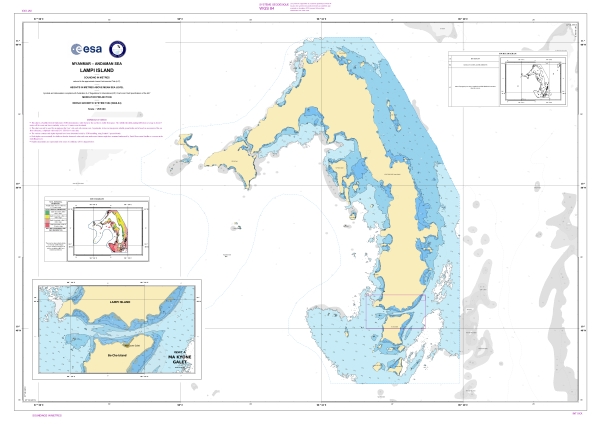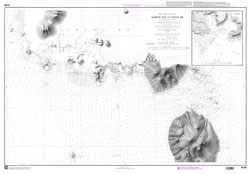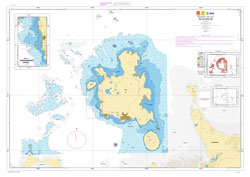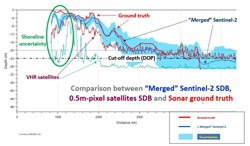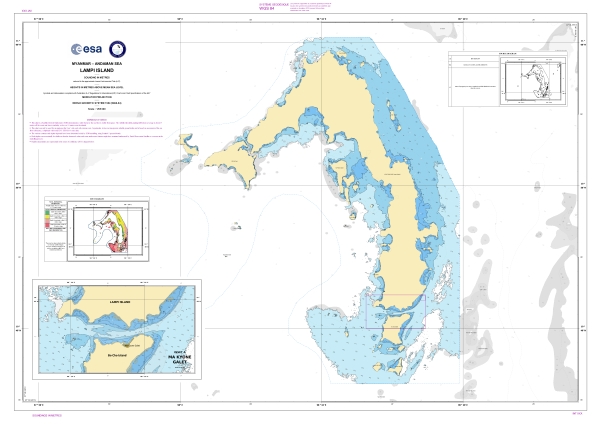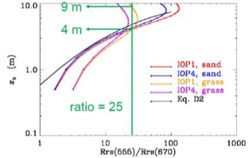Until recently, the exploitation of Earth Observation in the coastal domain had been limited by the complication of obtaining the right satellite image—but now Copernicus Sentinel-2 data are making a difference.
It is generally assumed that the world's coastal regions have been precisely surveyed by modern techniques and that resulting nautical charts are an accurate reflection of the real nature of the seabed. The world's Hydrographic Offices and the International Hydrographic Organisation do not agree.
Hydrographic Offices and the IHO have been searching to find an affordable method to fill the coastal gaps still affecting large parts of the world, especially in developing countries that cannot rely on costly ship-based sonar or slightly more reasonable Lidar surveys.
Robert Ward, the former IHO President, identified the possibilities offered by Satellite Derived Bathymetry (SDB) as the most promising method for the future.
Satellite Derived Bathymetry is not an exact science, but the ARGANS Ltd SDB team, comprising a unique mix of mathematicians, expert marine remote sensing scientists, and IHO qualified Charge hydrographers and maritime cartographers, with a strong pedigree in the marine domain, have tried to choose the parameters most likely to provide reliable solutions. This multidisciplinary approach ensures that an appropriate interpretive environment supports the scientific analysis and prioritises safety of navigation.
As a contribution to the safety of navigation in coastal shallow waters and in line with the science4society programme, ESA's Sentinel Coastal Charting Worldwide project was conceived to research whether the Sentinel-2 satellites of the European Union's Copernicus Programme have the capacity to fully survey the coastal gaps with reliable results, which would be obtained for an affordable price.
In the early eighties, it could take SDB pioneers several years to select a unique, cloud-free, unglinted SPOT scene, qualified for further processing. With the advent of high-resolution imagery and a larger choice of commercial very high resolution (VHR) satellites, SDB providers were later able to offer "best available" services.
However, their costly solutions would be greatly prohibitive to many nations where such a service would deliver the best benefit, so the ARGANS SDB team of hydrographers and EO scientists were determined to test other options.
VHR satellites yielding 0.5 metre resolution pixels, are not totally adapted to marine coastal environments characterised by low signal-to-noise ratio (S/N) in remote sensing, because of light attenuation in the water (the smaller the resolution, the smaller the S/N), and by broader natural structures, the smallest of which are seldom smaller than 100 sq. metres (e.g. coral pinnacles).
Thanks to ESA's coastal charting project, ARGANS has focused on the latest available Copernicus constellations and systematically compared Copernicus Sentinel-2's multispectral imager (MSI) performances against VHR imagery.
Due to the significant improvements brought by the constellation's five-day revisit time, coupled with its exceptionally calibrated 13-band multispectral imager, with excellent signal-to-noise ratios delivered by the sensors, this proved to be a ‘best available' solution.
ESA's test study focused on four coastal regions with differing conditions, delivering four demonstrator products. Puerto Morelos, Mexico, was selected to compare an existing chart produced by commercial VHR imagery. Madagascar was selected as an area covered with an antiquated survey to test and exploit fully the Copernicus Sentinel-2 data archive and apply ARGANS latest algorithms, the "Merge" and "DOP" methods, only made possible by Copernicus.Analysts are now provided with a large database of usable imagery over the coastal belt, which has demonstrated to deliver excellent results, as exemplified by the featured cross section.
Lampi Island, Myanmar, was chosen to show the effectiveness of SDB within turbid waters (an uncharted site previously used to test ESA's Sen2Coral project), and finally Coral Harbour, Canada, to explore how SDB with Copernicus Sentinel-2 would perform in the Arctic waters of the Northwest passage.
The team employed two physics-based processors both using the same Radiative Transfer Equations (RTE), which, when identically parameterised, yielded the same results for similar performances, i.e. 15 minutes per model as opposed to 8 hours for a 50 cm pixel image.
The "Merge" method consists of calculating weighted averages over each specific site to produce one bathymetry data set from a large stack of images, 53 in the Nosy Be test site.
Because of the existence of several possible depth solutions to the Radiometric Transfer Equations, validation criteria have to be applied, backed by mathematical developments and calculations of probabilities.
"Merge" allows ARGANS Ltd to take advantage of Copernicus Sentinel-2's data catalogue and remove errors from sediment plumes, clouds and other anomalies, thus yielding what the satellite community has started to call the 'Perfect Image'.
To compliment the merge methodology, ARGANS Ltd has also developed a Depth of Penetration (DOP) software as a validation tool to determine the theoretical maximum detection threshold, based purely on the colour of the ocean.
As a very simple validation check, any modelled result deeper than the DOP should be flagged, double-checked and most likely suppressed. DOP calculations measure the water transparency down to the "Secchi" extinction depth. This optical threshold developed for satellites can be applied to active systems such as LIDAR and could be extended globally.
Jean Laporte, Eng. General of the Armament Corps and Managing Director of ARGANS Ltd., declared, "With the advent of performing new generation satellites such as Copernicus Sentinel-2 and clarification of the relationship between rigorous radiation transfer equations and practical IHO charting standards, SDB has moved from being an exploratory concept to becoming an indispensable method for improving safety of navigation in shallow waters."
About the Copernicus Sentinels
The Copernicus Sentinels are a fleet of dedicated EU-owned satellites, designed to deliver the wealth of data and imagery that are central to the European Union's Copernicus environmental programme.
The European Commission leads and coordinates this programme, to improve the management of the environment, safeguarding lives every day. ESA is in charge of the space component, responsible for developing the family of Copernicus Sentinel satellites on behalf of the European Union and ensuring the flow of data for the Copernicus services, while the operations of the Copernicus Sentinels have been entrusted to ESA and EUMETSAT.
Acknowledgements:
The work featured in this story was funded by an ESA grant, with Dr Olivier Arino as ESA's Technical Officer. It was undertaken by the SDB team within ARGANS Ltd, led by Eng General Jean Laporte
